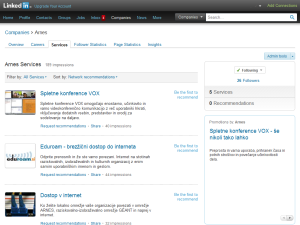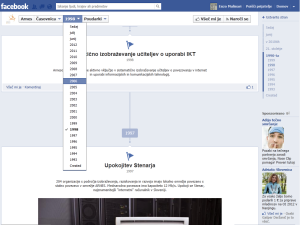...
Author: Domen Božeglav, ARNES, <domen.bozeglav@arnes.si>
ReviewReviewers: Laura Durnford, TERENA, <durnford@terena.org>, Gitte Julin Kudsk, <gitte.kudsk@uni-c.dk>
Introduction
The goal of the Social Media Jumpstart pack Pack is to help NRENs start their own Social Media presence or improve an existing one. The document aims mainly at communications-PR (or other) coordinators setting up the their NREN Social Media whereas , with some parts aimed at end users staff producing content - e. g. technical staff. It's not an overwhelming strategy but rather how to "How to..." directions you can use instantly.
This document was created by TF-CPR, the TERENA task force on communications and public relations, but all NREN employees are kindly invited to contribute to keep it updated as our Social Media usage matures.
The structure of the document is divided into 7 logical steps which imitate the natural top-to-bottom deployment of an NREN Social Media presence (some steps of deployment are further covered in further detail on the TERENA wiki space):
- Why do you need it
- Which Social Media are you talking about
- Evaluet Evaluate ROI (return on investment)
- Get the Management buy-in
- Deployment
- Start producing content and engage coworkersco-workers
- Measuring
- Where to go forward
- Where to go forward
The document was created by TF-CPR but all TERENA employees are kindly invited to contribute to the subsections of the document. It's also constant work in progress so expect updates as Social Media matures.
1. Answer the question “Why
...
does your NREN need Social Media?"
The most common reason for expanding our PR efforts to Social Media is "because others are on Social Media too". In our opinion this argument is wrong and if you don't exactly know , what you want to do with Social Media, better don't bother putting efforts into ityou'd be better off putting your effort elsewhere.
- Write down what you expect form from Social Media
- What’s your audience. ? Use "personas" if you have them available from other web projects. Be aware that a minority creates the majority of Social Media conversation.
- How do you plan to talk to your audience (in comparison to other channel) (in comparison to the way you would talk to them via other channels)?
- What do you consider as a success?
Before going any further, try to honestly answer this these two questions:
- Are you and your organisation ready to communicate on the new channels (Social Media is just a complementary channelset of channels)?
- Who are is going te to be communicating and - are they prepared to take enough time to do that properly?
If you can't answer above questions, feel free to explore the subject a bit further:
- How to Introduce Social Media to Your Business: when to and when not to expand your channels to Social Media
- Develop a Social Media Strategy in 7 Steps: how not to loose lose focus when deploying Social Media
- Understanding the Experience of Social Network Sites: don't just follow others. Understand what you are doing in and WHY you are doing it.
2. Decide which Social Media you are going to adapt
The Social Media space is changing as we speak - some applications cease to exist and some new emerge ones are emerging all the time . Though - although we are aware of some serious players that won't vanish through the night overnight (e.g. Facebook, Twitter, LinkedIn, Youtube ...). If you want to maintain the focus and momentum we suggest you decide on WHICH Social Media applications you are going to adopt.
For now (2012) NRENs are present on (in the app, order of frequency):
- Youtube
- Google+
- Blogspot
- Wikipedia
- Custom Social Media deployments and various blogs
For details an and live examples check the NREN Social Media presence wiki page, where you can explore how NRENs have set their Social Media presence. It's best if you start with one Social Media application and once adopted move to others.
If you can't decide on which Social Media to adopt, additional hints can be found at:
- Market analysis of social network platforms and their developments: the list hasn't been updated for a while but it still serves as a reference or pointer to more up-to-date information
- Social networking sites and our lives: which Social Media we use
- Social Media Examiner: use cases of various Social Media application uses
...
- With publishing on Social Media channels you will reach a broader audience.
- You will be able to reach people that who usually don't monitor your web page for news feeds.
- News editors and some decision makers are very active on Social Media. It's much easier to reach them now (Twitter)
- You can get instant feedbacks feedback on things you publish
- People are able to react on to your publishmentpublished output
- Social Media is a great place to launch less formal news
- Consistent Social Media presence can bring you higher brand awareness
Social Media requires constant involvement so don't underestimate the work you will have to invest to start Social Media and keep it going. Here are a few hints from our own experience:
- Deployment takes time. It can take from a single day to even a month or more if you want to exploit the full potential of applications (e.g. Facebook games, apps ...)
- Social Media constantly evolves so you will likely have to invest some more time as new feature features are available
- Content publishing on the Social Media is trivial but you will have to "fine tune in" the news a bit " your content to get better results. Avoid the use of RSS refeeds re-feeds on Social Media at all costs (WHY??)
- You'll have to take time to monitor what's going on and potentially answer addition additional questions from users, though tools that make that easier for you are freely available on the Internet (e.g. netwibes netvibes)
- Eventually you'll probably have to face "difficult users". Such appearances are rare but can take a lot of time and effort to solve.
- If possible have a person responsible for looking after Social Media in your team ...
So now, do the mathmaths. Also think about hiring a professional to do it for you. There are more and more firms also that are aware of NGOs (Non-governmental organisations) specifics e.g. Helpful Technology that , which led the TF-CPR Social Media training workshop in Belgrade in 2011.
4. Make the final decision and get
...
management “buy in”.
With Social Media in place at some stage you will definitely need management support, so now is the last best time to get their consent for the project. Try to incorporate Social Media into Company company culture. Since the management is on your side now it's an excellent opportunity to push forward a Company Social Media policy.
...
Government expects civil servants to adhere to the Civil Service Code online as well as offline.
Do check this out these additional examples of "light" examples of policy and guidelines:
- NPR's guidelines for using social netowrksnetworks will show you how journalists should use the Social Media
- The USA AirForce Air Force - Armed with Social Media will prove there are more strict organizations organisations than your NREN with much "slimmer" Social Media policy.
But if you need a more elaborate Social Media policy, the Social Media policy examples Wiki page offers you a few NREN and a lot of corporate extensive examples, or check a out Forresters "The CIO's Guide To Establishing A Social Media Policy".
...
- Learn from others. Be active and see for yourself what's working and what's not. Check the NREN Social Media presence Wiki page for ideas.
- You won't be able to monitor the entire Social Media space. Plan deploying various tools like netwibes such as netvibes to save you time once your applications will be are in production.
- Technology and applications are changing all the time. Instead of training employees for specific applications, think it in more general terms and give them "How to communicate on Social Media" like courses training that will keep still be of value even when you are migrating from e.g. Facebook to Pinterest.
- With If you have very limited resources for Social Media , you won't likely have a chance to be innovative with your Social Media usage. Learn from others if the knowledge is available - e.g. Do's and Don'ts of Social Media.
...
Facebook has the highest number of users so it's probably the best "usual suspect" to start with.
- Create you NREN your company page profile (don’t use groups since they will be depreciated and don’t create a personal profile for your company since it’s against the FB rules).
- Add company data, try to “talk to people” don’t just use facts.
- Use the new layout mode with a cover photo. We are visual beings and also Social Media is a lot about very visual thingsmedium.
- Publish as much many photos as you can - people will most likely check them out and engage on through them.
- Use the new Timeline feature and create your NREN history a bit more fun.
- Notify your colleagues about the new page and hopefully they will like it (and others will follow them).
...
- 13 Hot Facebook Marketing Tips From the Top Pros is a mock-up of advices , collected advice from Social Media experts
- Involver will help you with advices on advice about how to integrate various applications in Facebook
- And you can always rely on All Facebook, unofficial and Facebook pages - official Facebook cookbook.
...


